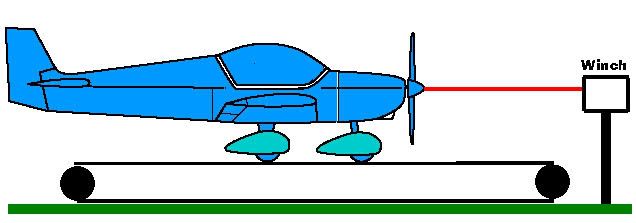45Auto
Commander
- Joined
- May 31, 2002
- Messages
- 2,842
Re: Airplane on a treadmill

Simplest way I can think to explain it. Anybody doubt that if the winch in the picture is turned on it pull the airplane forward till it hits the winch? Doesn't matter how fast the treadmill is going. If the winch is pulling cable in at 100 mph the airplane will move forward at 100 mph till it hits the winch. It'll take off and fly if it's stall speed is less than 100 mph. If the treadmill is running 100 mph in the opposite direction the wheels will be turning at 200 mph (airplane speed plus treadmill speed) even though the airplane is only going 100 mph towards the winch. Airplane doesn't know (or care) whether the wheels are going 10 mph or 100 mph or 1,000,000 mph. Wheel speed is always airplane speed plus treadmill speed. Has no affect on airplane speed. Unless you have bad bearings or hit the brakes, the airplane moves forward at the speed of the winch.
If you take off the winch and use the propellor it works the same way. The airplane doesn't know if it's being pulled by the winch or the propellor. Either one pulls the airplane forward through the air no matter how fast you run the treadmill. All the treadmill does is make the wheels turn faster which has no effect on the airplane speed (assuming real good bearings). The airplane's speed is independent of the wheel speed or relative ground (treadmill) speed.
Common belief is that the reason an airplane flies and a carb works is the Bernoulli Principle. Says an increase in fluid velocity causes a decrease in pressure. That's why the top surface of an airplane wing is curved (longer) so the air has to travel faster, thus less pressure on top of the wing so the wing lifts. A carburetor venturi is necked down (less area) so the air has to speed up to go through it, giving less pressure so fuel is sucked out of the float bowl.
In reality Bernoulli Principle doesn't explain airplane lift. It is frequently used to analyze it, which is probably where the misconception comes from.
Can you tell I'm kinda bored????

Simplest way I can think to explain it. Anybody doubt that if the winch in the picture is turned on it pull the airplane forward till it hits the winch? Doesn't matter how fast the treadmill is going. If the winch is pulling cable in at 100 mph the airplane will move forward at 100 mph till it hits the winch. It'll take off and fly if it's stall speed is less than 100 mph. If the treadmill is running 100 mph in the opposite direction the wheels will be turning at 200 mph (airplane speed plus treadmill speed) even though the airplane is only going 100 mph towards the winch. Airplane doesn't know (or care) whether the wheels are going 10 mph or 100 mph or 1,000,000 mph. Wheel speed is always airplane speed plus treadmill speed. Has no affect on airplane speed. Unless you have bad bearings or hit the brakes, the airplane moves forward at the speed of the winch.
If you take off the winch and use the propellor it works the same way. The airplane doesn't know if it's being pulled by the winch or the propellor. Either one pulls the airplane forward through the air no matter how fast you run the treadmill. All the treadmill does is make the wheels turn faster which has no effect on the airplane speed (assuming real good bearings). The airplane's speed is independent of the wheel speed or relative ground (treadmill) speed.
Common belief is that the reason an airplane flies and a carb works is the Bernoulli Principle. Says an increase in fluid velocity causes a decrease in pressure. That's why the top surface of an airplane wing is curved (longer) so the air has to travel faster, thus less pressure on top of the wing so the wing lifts. A carburetor venturi is necked down (less area) so the air has to speed up to go through it, giving less pressure so fuel is sucked out of the float bowl.
In reality Bernoulli Principle doesn't explain airplane lift. It is frequently used to analyze it, which is probably where the misconception comes from.
Can you tell I'm kinda bored????



















